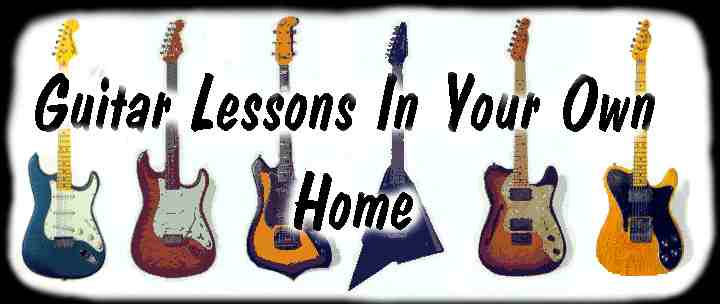If a student comes to me from another teacher.
There are usually four reasons I’ll get a student from another teacher; 1) if a student moves from a different area and cannot go to their old teacher anymore, 2) if the student completes group lessons and decides to continue with guitar, 3) if a parent is dissatisfied with a previous teacher or, 4) if a child who lost interest and stopped taking lessons for more than 6 months, decides to restart.
When a child has taken group lessons they’ve probably been given a small taste of what private lessons are like but they’re still technically beginners. I’ll usually start these children from the beginning (Click here).
If your child hasn’t taken lessons for a prolonged period of time I’ll give several review lessons, assess where they’re at and start the new lessons from that point.
If a parent or student is dissatisfied with another teacher I’ll ask to look at the previous teacher’s instruction books or curriculum and listen to the child play to see exactly what they were taught. We’ll discuss what the problem was with the previous teacher and I’ll pick up the lessons from there.
If a student moves from another area a particular problem may arise. It doesn’t matter whether the previous teacher was, in my opinion, doing a good job or bad job. If the child bonded with that teacher nothing I can do will help. The child misses their old teacher (and their old life) and may not bond with me. The more attached they were to the previous teacher the longer it will take to be successful. In my years of teaching this is the one problem I’ve encountered that can end quickly with a student bouncing from teacher to teacher.
How I teach guitar.
I tailor my lessons to the desires and goals of each student, as well as their parents. All are treated as individuals. If your child comes to me from another teacher it may take them several weeks to acclimate to my style of teaching.
There are three basic ways most guitar teachers communicate musically with your child; 1) traditional note reading, 2) guitar TAB, and 3) having the student visually memorizing and imitating what the teacher is playing. All have pros and cons. Traditional Musical Notation is the universal language that professional musicians read. Now, its main use is in enabling musicians on different instruments to communicate with other musicians on the same musical level. It wasn’t always like this though. Before audio recordings if a symphony written in Paris was taken to Moscow to be played, the only way this could be done was with a standardized form of musical notation. It was their version of an audio recording and the new interpretation was unique as the original version could not be heard in Moscow. Now music reading has become a skill that many mistakenly believe you need in order to play the guitar – but this is not so. For a guitarist the downside is standard musical notation only gives the pitch and duration of a note, it doesn’t tell where on the fretboard to play it. This is a tremendous problem for guitarists and when we communicate amongst ourselves we usually use a simpler and more precise method, guitar TAB (tableture). This communicates to a guitarist, on paper, exactly what another guitarist is doing. I can teach anyone the essentials of TAB and have them play their first song in five minutes. With traditional note reading it may take several weeks to get the same result. This is why so many guitarists, and guitar teachers, don’t read conventional music. I’ve come across students from other teachers who communicated with them the third way by visually memorizing and imitating what their teacher’s play. Nothing is written down and this method can have the biggest problems as many students will not remember the song correctly after the lesson and practice mistakes all week long.
I firmly believe the lesson should be written out somehow and if a student began studying with me they would have both the basics of note reading and TAB down. Many students come to me playing a second instrument and already know how to read music and for them note reading on a second instrument is usually not a problem. Basic note reading is an important musical skill and every musician should have some exposure to it. But as not every guitar teacher knows how to read music I get many students who can only communicate musically in the way they were taught. A student who only has a repertoire of a few simple songs to play may have also been taught very little musical structure. If the student is younger this can be corrected but if a student is a teenager there are problems. Many have no interest in traditional note reading or theory and will refuse to learn it. Even if they try to learn they may not be successful. The reason is when you already know how to play it’s very difficult to go back and become a beginner again. This is exactly what it’s like to try and learn traditional note reading when you already know how to play the guitar. It’s difficult and with a student like this I’ll probably suggest just picking up where the previous teacher left off. I’ll give them increasingly challenging material to work on using TAB and try to throw in musical knowledge wherever I can.
Some parents want guitar lessons to be as enjoyable as possible for their overstressed and overworked children and these parents specifically ask me not to teach their children how to read music. I will tailor the guitar lessons to whatever you wish.
As technical ability increases with most students harder songs and solos are introduced. Music theory and improvisation are also taught from my own workbook using jam CDs recorded especially for this purpose. Eventually students are encouraged to pick some of the popular Rock’n’Roll songs they wish to learn. My years as a professional transcriber help me in writing these songs out during the lesson. I’m very good at picking out guitar music by ear.
Each student learns at a different level. In over forty years of experience, I’ve developed a very patient teaching style. I’m tough on students who don’t practice but I never belittle or discourage a slower student or one that has very little time to commit. Neither fast nor slower learning speeds pose any problem to me. At least half of my children are non-beginners or dissatisfied students that came to me from other teachers.
Parents often ask me to give their children longer lessons. Unless a student is learning at a tremendous pace I can easily fit everything in one half hour because I’ve taken the time to compose my own lesson syllabus workbook. Some 45 minute to one hour teachers waste valuable playing time spending much of the lesson physically writing out the same basic materials for each student. I don’t have to write anything out and my students are playing during their lessons (unless they wish to learn a song I don’t know, and I write that out for them during the lesson).
I always encourage song writing and performance in a band. Bands regularly record at my studio and my rehearsal room is available for rent. For more advanced players I try to open up the different guitar styles that younger students might not be initially interested in such as Blues, Jazz, or Classical.
The qualities of a successful student.
Here are the four main attributes you must have to play guitar well:
Mental quickness – The faster a person thinks the quicker they can understand and play music. In turn learning to read music and play an instrument will build and sharpen a student’s mental agility.
Physical Dexterity – Fast fingers are best, but slow movement can be overcome with practice.
Desire – This is instilled in a young child by seeing someone they love playing or singing with a guitar. Having a toy guitar around will peak curiosity and desire in a child. Seeing and emulating famous musicians and bands inspire older children.
Practice time – All students must spend time playing their guitar. Sometimes priorities have to be rearranged. If your child practices they will excel at playing guitar.
What are the parental responsibilities.
Being that your child has already taken lessons they may have a set practice routine already. I give my students about 15 minutes of material to practice each week and I ask them to repeat everything twice which will add up to half an hour practice time. My suggestion is they practice four times a week. This will give your child around two hours a week added to their regular half hour lesson. (students under 7 can do less). If a student excels and does more than two hours per week it’s better and they’ll be given more work to do, but less practice is unacceptable. Parents must be involved in listening in and making sure their child is playing regularly. Having a set practice time each day works best.
What can you expect from lessons.
It’s impossible to predict how successful a student will be after changing teachers. I try my best to keep each student interested and moving forward, but some children don’t like to practice or simply don’t have the time. If this is the problem they had with a previous teacher it may be the same with me. Your child will get out of their guitar lessons what they put in. Any amount of time spent playing is directly proportional to to an increase in their ability level. Even 5 minutes a day is better than nothing.
Where are the lessons given.
I give lessons in your own home as this is not only convenient & less distracting it also helps a student feel comfortable during their lesson.
How are payments arranged.
Each lesson is one half hour long. You’re charged a flat monthly rate and payment is due at the end of the month after the lessons are given. You will not be charged if a lesson is missed, but I do ask that all cancellations be made up. I have convenient openings. Please call me at (914) 741-6321 and we’ll set up a time to meet. I have excellent references, if you like, and look forward to hearing from you… Thanks
Call 914-741-6321 and please leave the;
1. Name and age of student
2. Phone number
3. Town where you reside
Very Important: If sending an e-mail please put “Guitar lessons” in the subject line.

